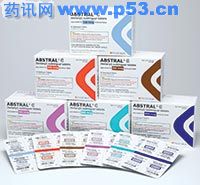Manufacturer:
ProStrakan Inc.
Pharmacological Class:
Opioid.
Active Ingredient(s):
Fentanyl 100mcg, 200mcg, 400mcg, 600mcg, 800mcg; sublingual tablets.
Indication(s):
Breakthrough pain, in opioid-tolerant patients already receiving and who are tolerant to continuous opioid therapy for underlying persistent cancer pain. Opioid-tolerant patients are those taking: Oral morphine ≥60mg/day, oxycodone ≥30mg/day, hydromorphone ≥8mg/day, oxymorphone ≥25mg/day, or equianalgesic dose of another opioid for ≥1 week; or transdermal fentanyl ≥25mcg/hr.
Pharmacology:
Like other pure opioid agonists, fentanyl acts on the mu-receptors in the CNS to produce analgesia and CNS depression.
Clinical Trials:
A double-blind, placebo-controlled, crossover study was performed in cancer patients to evaluate the efficacy of Abstral in treating breakthrough cancer pain. Open-label titration identified a dose of Abstral in which a patient obtained adequate analgesia with tolerable side effects, within the range of 100–800mcg. Patients who identified a successful dose were randomized to a sequence of 10 treatments; 7 with Abstral and 3 with placebo.
Of the 131 patients who entered the titration phase of the study, 60% achieved a successful dose during the titration phase. The primary outcome measure, the mean sum of pain intensity difference at 30 minutes for Abstral-treated episodes was statistically significantly higher than for placebo-treated episodes. A significant difference in mean pain intensity difference was seen at 10 minutes.
Legal Classification:
CII
Adults:
≥18 years: Do not chew, suck, swallow tablets. Allow tablets to dissolve in sublingual cavity. Do not eat or drink until tablet completely dissolves. Individualize. Initially one 100mcg dose; if adequate analgesia is obtained within 30 minutes, continue to treat subsequent episodes with this dose. If inadequate, give 2nd dose (after 30 minutes). For future episodes, if analgesia is not obtained with 100mcg dose, titrate in increments of 100mcg up to 400mcg as needed; if 400mcg dose is inadequate, titrate to 600mcg dose, then 800mcg dose if needed. May use 100mcg or 200mcg tablets for any single dose; maximum 4 tablets at one time. Max 2 doses/episode, up to 4 episodes/day. Wait at least 2 hours before treating another episode. Maintenance: use only one tablet of appropriate strength. Do not convert from other fentanyl products on a mcg per mcg basis or interchange with other fentanyl products. Rescue medication may be used.
Children:
<18 years: not recommended.
Contraindication(s):
Not for opioid non-tolerant patients. Acute or post-op pain (including headache/migraine, dental pain, or ER).
Warnings/Precautions:
Respiratory disorders or depression. Head injury. Increased intracranial pressure. Bradyarrhythmias. Impaired pulmonary, cardio, renal, or hepatic function. Elderly. Debilitated. Pregnancy (Cat.C). Labor & delivery, nursing mothers: not recommended.
Interaction(s):
Not recommended within 14 days of MAOIs. Potentiates CNS depression with alcohol, other CNS depressants (eg, phenothiazines, skeletal muscle relaxants, antihistamines, hypnotics). Potentiated by CYP3A4 inhibitors (eg, macrolides, azole antifungals, aprepitant, protease inhibitors, nefazodone, verapamil, diltiazem). Antagonized by CYP3A4 inducers (eg, barbiturates, efavirenz, modafinil, nevirapine, anticonvulsants, pioglitazone, troglitazone, rifabutin, rifampin, St John’s wort).
Adverse Reaction(s):
Nausea, somnolence, headache, constipation; respiratory/circulatory depression.
Notes:
Available by restricted distribution program. Call (888) 227-8725 to enroll. Properly handle and dispose; may be fatal to children.
How Supplied:
Sublingual tabs—32
Last Updated:
3/2/2011


